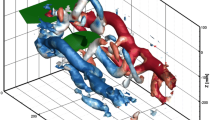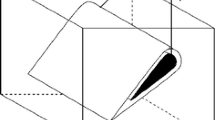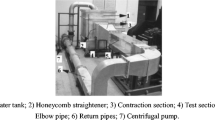Abstract
The understanding of the physics of flapping flight has long been limited due to the obvious experimental difficulties in studying the flow field around real insects. In this study the time-dependent three-dimensional velocity field around a flapping wing was measured quantitatively for the first time. This was done using a dynamically-scaled wing moving in mineral oil in a pattern based on the kinematics obtained from real insects. The periodic flow is very reproducible, due to the relatively low Reynolds number and precise control of the wing. This repeatability was used to reconstruct the full evolving flow field around the wing from separate stereoscopic particle image velocimetry measurements for a number of spanwise planes and time steps. Typical results for two cases (an impulsive start and a simplified flapping pattern) are reported. Visualizations of the obtained data confirm the general picture of the leading-edge vortex that has been reported in recent publications, but allow a refinement of the detailed structure: rather than a single strand of vorticity, we find a stable pair of counter-rotating structures. We show that the data can also be used for quantitative studies, such as lift and drag prediction.












Similar content being viewed by others
Notes
It should be noted that there are alternative definitions in the literature for the Reynolds number of a flapping wing (e.g., using the mean tip velocity, instead of the maximum). Due to the nature of the wing kinematics chosen in this study, the choice for the maximum tip velocity will become obvious.
An a posteriori analysis using the obtained out-of-plane motion made evident that the out-of-plane tracer displacement was always smaller than a quarter of the light sheet thickness for the chosen delay times.
Passive deformation refers to deformation by aerodynamic or inertial forces, i.e., not due to actual control by muscles.
The chord length is relatively constant over the span of the wing, except for the tip region, corresponding to roughly the last 10–20% of the wing. For simplicity only one value is used here.
While this value is rather arbitrary, the results did not change significantly with different threshold values.
References
Adrian R (1997) Dynamic ranges of velocity and spatial resolution of particle image velocimetry. Meas Sci Technol 8:1393–1398
Batchelor GK (1974) An introduction to fluid dynamics. Cambridge University Press, Cambridge
Birch JM, Dickinson MH (2001) Spanwise flow and the attachment of the leading-edge vortex on insect wings. Nature 412:729–733
Birch JM, Dickinson MH (2003) The influence of wing–wake interactions on the production of aerodynamic forces in flapping flight. J Exp Biol 206:2257–2272
Birch JM, Dickson WB, Dickinson MH (2004) Force production and flow structure of the leading edge vortex on flapping wings at high and low Reynolds numbers. J Exp Biol 207(7):1063–1072
Bomphrey RJ, Lawson NJ, Harding NJ, Taylor GK, Thomas ALR (2005) The aerodynamics of Manduca sexta: digital particle image velocimetry analysis of the leading-edge vortex. J Exp Biol 208:1079–1094
Bomphrey RJ, Taylor GK, Lawson NJ, Thomas ALR (2006a) Digital particle image velocimetry measurements of the downwash behind a desert locust Schistocerca gregaria. J R Soc Interface 3(7):311–317
Bomphrey RJ, Lawson NJ, Taylor GK, Thomas ALR (2006b) Application of digital particle image velocimetry to insect aerodynamics: measurement of the leading-edge vortex and wake of a Hawkmoth. Exp Fluids 40(4):546–554
Combes SA, Daniel TL (2003) Flexural stiffness in insect wings. II. spatial distribution and dynamic wing bending. J Exp Biol 206:2989–2997
Dabiri JO (2005) On the estimation of swimming and flying forces from wake measurements. J Exp Biol 208:3519–3532
Dabiri JO (2006) Note on the induced lagrangian drift and added-mass of a vortex. J Fluid Mech 547:105–113
Dickinson MH, Lehmann F-O, Sane SP (1999) Wing rotation and the aerodynamic basis of insect flight. Science 284(5422):1954–1960
van Doorne CWH, Westerweel J, Nieuwstadt FTM (2004) Measurement uncertainty of stereoscopiv-piv for flow with large out-of-plane motion. In: Proceedings of the EUROPIV 2 workshop held in Zaragoza, Spain, March 31–April 1, 2003, pp 213–227
Dubief Y, Delcayre F (2000) On coherent-vortex identification in turbulence. J Turbulence 1:1–22
Ellington CP, Van den Berg C, Willmott AP, Thomas ALR (1996) Leading-edge vortices in insect flight. Nature 384:626–630
Fry SN, Sayaman R, Dickinson MH (2003) The aerodynamics of free-flight maneuvers in Drosophila. Science 300(5618):495–498
Fry SN, Sayaman R, Dickinson MH (2005) The aerodynamics of hovering flight in Drosophila. J Exp Biol 208(12):2303–2318
Hedenström A, Rosén M, Spedding GR (2006) Vortex wakes generated by robins erithacus rubecula during free flight in a wind tunnel. J R Soc Interface 3(7):263–276
Keane RD, Adrian RJ (1992) Theory of cross-correlation analysis of PIV analysis. Appl Sci Res 49:191–215
Meinhart CD, Wereley ST, Santiago JG (2000) A PIV algorithm for estimating time-averaged velocity fields. J Fluids Eng 122:285–289
Milano M, Gharib M (2005) Uncovering the physics of flapping flat plates with artificial evolution. J Fluid Mech 534:403–409
Minotti FO, Speranza E (2005) Leading-edge vortex stability in insect wings. Phys Rev E 71:051908
Noca F, Shiels D, Jeon D (1999) A comparison of methods for evaluating time-dependent fluid dynamic forces on bodies, using only velocity fields and their derivatives. J Fluids Struct 13(5):551–578
Rayner JMV (1979) A vortex theory of animal flight .1. Vortex wake of a hovering animal. J Fluids Mech 91:697–730
Sane SP, Dickinson MH (2002) The aerodynamic effects of wing rotation and a revised quasi-steady model of flapping flight. J Exp Biol 205:1087–1096
Spedding GR, Rayner JMV, Pennycuick CJ (1984) Momentum and energy in the wake of a pigeon (Columba livia) in slow flight. J Exp Biol 111:81–102
Spedding GR, Rosén M, Hedenström A (2003) A family of vortex wakes generated by a thrush nightingale in free flight in a wind tunnel over its entire natural range of flight speeds. J Exp Biol 206:2313–2344
Stanislas M, Okamoto K, Kähler CJ, Westerweel J (2005) Main results of the second international PIV challenge. Exp Fluids 39:170–191
Taylor GK, Nudds RL, Thomas ALR (2003) Flying and swimming animals cruise at a strouhal number tuned for high power efficiency. Nature 425:707–711
Usherwood JR, Ellington CP (2002) The aerodynamics of revolving wings—I. model hawkmoth wings. J Exp Biol 205(11):1547–1564
Von Ellenrieder KD, Parker K, Soria J (2003) Flow structures behind a heaving and pitching finite-span wing. J Fluid Mech 490:129–138
Wang ZJ (2000) Two dimensional mechanism for insect hovering. Phys Rev Lett 85(10):2216–2219
Wang ZJ (2005) Dissecting insect flight. Annu Rev Fluid Mech 37:183–210
Westerweel J (1994) Efficient detection of spurious vectors in particle image velocimetry data. Exp Fluids 16:236–247
Wieneke B (2005) Stereo-PIV using self-calibration on particle images. Exp Fluids 39:267–280
Willert CE (1997) Stereoscopic digital particle image velocimetry for application in wind tunnel flows. Meas Sci Technol 8:1465–1479
Willmott AP, Ellington CP (1997) The mechanics of flight in the hawkmoth Manduca sexta. I. kinematics of hovering and forward flight. J Exp Biol 200:2705–2722
Wu JC (1981) Theory for aerodynamic florce and moment in viscous flows. AIAA J 19(4):432–441
Acknowledgments
Support from The Netherlands Organization for Scientific Research (NWO) in the form of a ‘Talent’ Fellowship is gratefully acknowledged (CP). Additional support was provided by a grant from the National Science Foundation, the Packard Foundation and the Office of Naval Research (MHD).
Author information
Authors and Affiliations
Corresponding author
Rights and permissions
About this article
Cite this article
Poelma, C., Dickson, W.B. & Dickinson, M.H. Time-resolved reconstruction of the full velocity field around a dynamically-scaled flapping wing. Exp Fluids 41, 213–225 (2006). https://doi.org/10.1007/s00348-006-0172-3
Received:
Revised:
Accepted:
Published:
Issue Date:
DOI: https://doi.org/10.1007/s00348-006-0172-3




